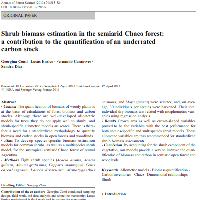Resumen
-
Context The quantification of biomass of woody plants is at the basis of calculations of forest biomass and carbon stocks. Although there are well-developed allometric models for trees, they do not apply well to shrubs, and shrub-specific allometric models are scarce. There is therefore a need for a standardized methodology to quantify biomass and carbon stocks in open forests and woodlands. Aims To develop species-specific biomass estimation models for common shrubs, as well as a multispecies shrub model, for the subtropical semiarid Chaco forest of central Argentina. Methods Eight shrub species (Acacia aroma, Acacia gilliesii, Aloysia gratissima, Capparis atamisquea, Celtis ehrenbergiana, Larrea divaricata, Mimozyganthus carinatus, and Moya spinosa) were selected, and, on average, 30 individuals per species were harvested. Their total individual dry biomass was related with morphometric variables using regression analysis. Results Crown area as well as crown-shaped variables proved to be the variables with the best performance for both species-specific and multispecies shrub models. These allometric variables are thus recommended for standardized shrub biomass assessments.
Conclusion By accounting for the shrub component of the vegetation, our models provide a way to improve the quantification of biomass and carbon in semiarid open forest and woodlands.
